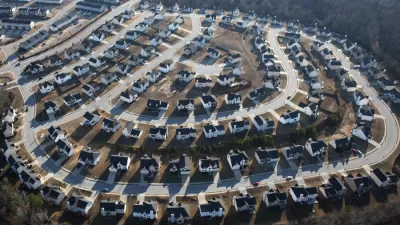How the rigidity of modern suburban development fails to prepare cities for the future.

Drawing on his experience in Annapolis, Maryland, Edward Erfurt highlights how older cities make better use of space than suburban developments. In Annapolis, Erfurt writes, “The city evolved organically, filling in nooks and crannies with buildings and spaces that adapted to the existing topography and ownership patterns.”
According to Erfurt, Annapolis is a city full of “irregularly shaped lots and buildings” that are squeezed into nooks and crannies to maximize the use of space. The result is a uniquely charming — and functional — urban landscape.
Suburban development, on the other hand, “is rigid, designed to be ‘complete’ upon construction with little expectation for future growth or change.” It also wastes resources by duplicating infrastructure, such as roads, that go largely underused. For Erfurt, “By building to a "finished state," suburban developments sacrifice the possibility of future expansion and adaptability.”
Erfurt offers some examples of ‘nook and cranny urbanism’ that could make modern cities more adaptable and diverse. These include “Positioning buildings closer to the street or corners of lots,” “Placing utilities strategically along future corridors” to reduce the cost of future development, and “Designing flexible parking layouts” that allow for future redevelopment of parking lots. Changes like these could yield a more “productive and sustainable model” for city planning that actively prepares for future change and growth.
FULL STORY: Nook and Cranny Urbanism: How To Maximize Every Inch of Space

Florida Considers Legalizing ADUs
Current state law allows — but doesn’t require — cities to permit accessory dwelling units in single-family residential neighborhoods.

Manufactured Crisis: Losing the Nation’s Largest Source of Unsubsidized Affordable Housing
Manufactured housing communities have long been an affordable housing option for millions of people living in the U.S., but that affordability is disappearing rapidly. How did we get here?

Research Shows More Roads = More Driving
A national study shows, once again, that increasing road supply induces additional vehicle travel, particularly over the long run.

EV Chargers Now Outnumber Gas Pumps by Nearly 50% in California
Fast chargers still lag behind amidst rapid growth.

Affordable Housing Renovations Halt Mid-Air Amidst DOGE Clawbacks
HUD may rescind over a billion dollars earmarked for green building upgrades.

Has Anyone at USDOT Read Donald Shoup?
USDOT employees, who are required to go back to the office, will receive free parking at the agency’s D.C. offices — flying in the face of a growing research body that calls for pricing parking at its real value.
Urban Design for Planners 1: Software Tools
This six-course series explores essential urban design concepts using open source software and equips planners with the tools they need to participate fully in the urban design process.
Planning for Universal Design
Learn the tools for implementing Universal Design in planning regulations.
City of Moreno Valley
Institute for Housing and Urban Development Studies (IHS)
City of Grandview
Harvard GSD Executive Education
City of Piedmont, CA
NYU Wagner Graduate School of Public Service
City of Cambridge, Maryland





























